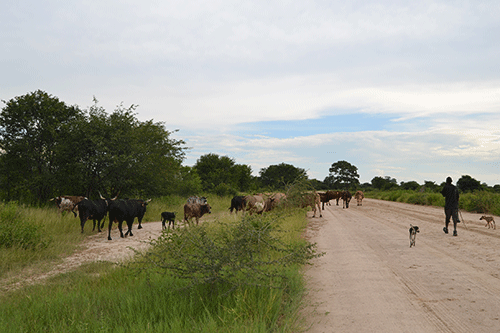SIBBINDA – Despite having quality meat and healthy livestock, farmers in the Zambezi region are dissatisfied with the prices of their produce fetch, as many resort to the informal meat trade.
They sell their meat under the trees alongside the main roads from Kongola, leading to Katima Mulilo, hoping motorists will be attracted.
For many years, farmers from this part of the country did not have a market for their livestock products and could not benefit from the luxury markets where Meatco is exporting products from south of the veterinary cordon fence.
The northern communal areas (NCA) are a strategically important market for Meatco, and the company has invested millions in the development of the NCA facilities since 1992.
Unfortunately, many factors, including foot and mouth disease outbreaks, inadequate road network and vast distances, hamper delivery to Meatco.
According to the directorate of veterinary services statistics, the NCA, comprising Zambezi, Kavango East, Kavango West, Oshikoto, Ohangwena, Omusati, Oshana and Kunene regions, is a livestock-rich part of Namibia, with approximately 1.6 million cattle, representing 64% of the national cattle herd, estimated to be at 2.5 million.
Despite the drought, the Zambezi region received the highest rainfall countrywide, with an average of 600mm, compared to other regions.
Most farmers complained that even the available platform to sell through Meatco is not helping them much, as the slaughter queue is so long, while others feel Meatco prices are not fair and worth the quality of their animals.
“We have quality and good beef, but there is no market. We are making a loss because we end up selling our cow for even N$2 500 when such an animal should fetch at least N$8 000 or N$10 000 under normal circumstances. You can see I still have a lot of meat, but there are no customers. People from the villages do not have money to buy a lot of meat. We end with a lot of meat leftovers, which we sell as dried meat,” complained Sibbinda farmer Ivan Mabuku.
Farmers sell a good piece of fresh beef for a mere N$10, while a wad of dried meat is sold for N$20.
Sibbinda, being one of the most densely populated constituencies, is home to over 100 cattle posts, with no fencing. The area is also upper land, with a thick forest, and it is blessed with fertile land, making it the largest producer of maize in the region.
Sibbinda councillor Mickey Lukaezi, who is also a local farmer, said: “We have good grazing, but we have a challenge of water. The government is trying to drill two boreholes, but the aquifer is very low. You need the supervision of hydrologists to drill a borehole in the area,” he said.
According to him, the livestock market is a challenge due to the long queue at Meatco.
“When you go to Meatco in Katima, the queue is too long to register. Meatco prices are better. People decided to slaughter their cattle and sell in the villages, on the streets and alongside the road for N$10 a piece of meat,” he said.
Lukaezi narrated how he made a loss by selling some of his cattle, as he urgently needed money to settle registration fees for his nephew, who wanted to go to university.
“I gave a big cow to my nephew, who wanted to go to university. When it was sold on the market, it only managed to sell for N$2 500, while the registration fee is N$5 000. I had to sacrifice another one – a big one – for N$2 500. I have livestock, but there is no market. We only trade within the region,” Lukaezi indicated.
Zambezi governor Lawrence Sampofu said farmers bring their livestock to Zamco/Meatco, where these animals are quarantined for 30 days before slaughter.
“Last year, we started trading meat with Angola and Ghana. This is good to participate in international trade. If a person needs money urgently, they sell and slaughter, while others take to Zamco/Matco,” he said.
Sampofu appealed to local farmers to report any case of foot and mouth disease once detected. He cautioned farmers not to move livestock at night in an attempt to avoid roadblocks.
In 2020, cabinet gave a directive to Meatco to cooperate with state-owned abattoirs and meat processing facilities, especially the Rundu abattoir that was built by the agriculture ministry to fill the gap of NCA farmers.
Katima Mulilo abattoir has the capacity to slaughter 60 cattle per day.
Finance ministry spokesperson, under which Meatco falls, Wilson Shikoto, said beef from NCA, through the Katima Mulilo abattoir, is currently finding its space in the Ghanaian market, Angola and DRC.
“The issues of foot and mouth disease and lung sickness outbreaks remain a challenge for abattoirs in the NCAs to operate effectively and sustainably.
However, Shikoto said there is a strong chance to realise the opportunities in the NCA with the passing of the code of good practice under the Public Procurement Act.
“We expect [government offices, ministries and agencies] OMAs to fully comply with the procurement of NCA meat and meat products within the NCA and ultimately increase investments in the livestock subsectors of the northern communal areas,” he noted.
Thus far, he said, 14 tonnes of beef was shipped to Ghana last year, 152 tonnes were exported to Angola and 2.5 tonnes to DRC, respectively.
“However, due to the FMD and lung sickness outbreaks, livestock marketing was suspended. We anticipate trade to resume and pick up this year. In addition to this, beef from NCA is currently being consumed here in the country, south of the veterinary cordon fence, through commodity-based trade protocols.
Further, he said, Meatco is in its final discussions to open the Middle East market to begin exporting NCA beef into this market.
– anakale@nepc.com.na
Pic: farmers
Caption:
Cheap… Local farmers bemoan the lack of a livestock market in the Zambezi region.
Photo: Albertina Nakale


